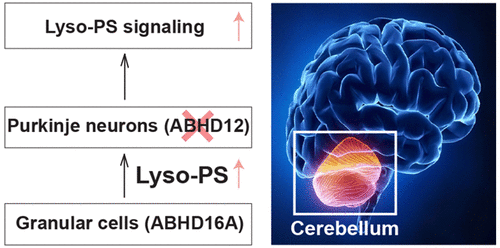当前位置:
X-MOL 学术
›
Biochemistry
›
论文详情
Our official English website, www.x-mol.net, welcomes your
feedback! (Note: you will need to create a separate account there.)
Mapping the Neuroanatomy of ABHD16A, ABHD12, and Lysophosphatidylserines Provides New Insights into the Pathophysiology of the Human Neurological Disorder PHARC.
Biochemistry ( IF 2.9 ) Pub Date : 2020-05-28 , DOI: 10.1021/acs.biochem.0c00349 Shubham Singh 1 , Alaumy Joshi 1 , Siddhesh S Kamat 1
Biochemistry ( IF 2.9 ) Pub Date : 2020-05-28 , DOI: 10.1021/acs.biochem.0c00349 Shubham Singh 1 , Alaumy Joshi 1 , Siddhesh S Kamat 1
Affiliation

|
Lysophosphatidylserine (lyso-PS), a lysophospholipid derived from phosphatidylserine (PS), has emerged as a potent signaling lipid in mammalian physiology. In vivo, the metabolic serine hydrolases ABHD16A and ABHD12 are major lipases that biosynthesize and degrade lyso-PS, respectively. Of biomedical relevance, deleterious mutations to ABHD12 cause accumulation of lyso-PS in the brain, and this deregulated lyso-PS metabolism leads to the human genetic neurological disorder PHARC (polyneuropathy, hearing loss, ataxia, retinitis pigmentosa, and cataract). While the roles of ABHD16A and ABHD12 in lyso-PS metabolism in the mammalian brain are well established, the anatomical and (sub)cellular localizations of both lipases and the functional cross-talk between them with respect to regulating lyso-PS lipids remain under investigated. Here, using subcellular organelle fractionation, biochemical assays, and immunofluorescence-based high-resolution microscopy, we show that the PS lipase ABHD16A is an endoplasmic reticulum-localized enzyme, an organelle intricately regulating cellular PS levels. In addition, leveraging immunohistochemical analysis using genetic ABHD16A and ABHD12 knockout mice as important controls, we map the anatomical distribution of both of these lipases in tandem in the murine brain and show for the first time the distinct localization of these lipases to different regions and cells of the cerebellum. We complement the aforementioned immunohistochemical studies by quantitatively measuring lyso-PS concentrations in various brain regions using mass spectrometry and find that the cerebellar lyso-PS levels are most affected by deletion of ABHD16A (decreased) or ABHD12 (increased). Taken together, our studies provide new insights into lyso-PS signaling in the cerebellum, the most atrophic brain region in human PHARC subjects.
中文翻译:

绘制 ABHD16A、ABHD12 和溶血磷脂酰丝氨酸的神经解剖图为人类神经疾病 PHARC 的病理生理学提供了新的见解。
溶血磷脂酰丝氨酸 (lyso-PS) 是一种衍生自磷脂酰丝氨酸 (PS) 的溶血磷脂,已成为哺乳动物生理学中一种有效的信号脂质。体内,代谢丝氨酸水解酶 ABHD16A 和 ABHD12 是主要的脂肪酶,分别生物合成和降解 lyso-PS。与生物医学相关的是,ABHD12 的有害突变会导致大脑中溶血-PS 的积累,而这种失调的溶血-PS 代谢会导致人类遗传性神经系统疾病 PHARC(多发性神经病、听力丧失、共济失调、色素性视网膜炎和白内障)。虽然 ABHD16A 和 ABHD12 在哺乳动物脑中溶血-PS 代谢中的作用已得到充分确立,但两种脂肪酶的解剖学和(亚)细胞定位以及它们之间在调节溶血-PS 脂质方面的功能交互作用仍在研究中. 在这里,使用亚细胞器分离、生化分析和基于免疫荧光的高分辨率显微镜,我们表明 PS 脂肪酶 ABHD16A 是一种内质网定位酶,一种复杂调节细胞 PS 水平的细胞器。此外,利用使用基因 ABHD16A 和 ABHD12 敲除小鼠作为重要对照的免疫组织化学分析,我们绘制了这两种脂肪酶在鼠脑中串联的解剖分布图,并首次显示了这些脂肪酶在不同区域和细胞中的不同定位。的小脑。我们通过使用质谱法定量测量不同大脑区域中的溶血-PS 浓度来补充上述免疫组织化学研究,并发现小脑溶血-PS 水平受 ABHD16A(降低)或 ABHD12(增加)缺失的影响最大。总之,我们的研究为小脑中的 lyso-PS 信号传导提供了新的见解,
更新日期:2020-06-23
中文翻译:

绘制 ABHD16A、ABHD12 和溶血磷脂酰丝氨酸的神经解剖图为人类神经疾病 PHARC 的病理生理学提供了新的见解。
溶血磷脂酰丝氨酸 (lyso-PS) 是一种衍生自磷脂酰丝氨酸 (PS) 的溶血磷脂,已成为哺乳动物生理学中一种有效的信号脂质。体内,代谢丝氨酸水解酶 ABHD16A 和 ABHD12 是主要的脂肪酶,分别生物合成和降解 lyso-PS。与生物医学相关的是,ABHD12 的有害突变会导致大脑中溶血-PS 的积累,而这种失调的溶血-PS 代谢会导致人类遗传性神经系统疾病 PHARC(多发性神经病、听力丧失、共济失调、色素性视网膜炎和白内障)。虽然 ABHD16A 和 ABHD12 在哺乳动物脑中溶血-PS 代谢中的作用已得到充分确立,但两种脂肪酶的解剖学和(亚)细胞定位以及它们之间在调节溶血-PS 脂质方面的功能交互作用仍在研究中. 在这里,使用亚细胞器分离、生化分析和基于免疫荧光的高分辨率显微镜,我们表明 PS 脂肪酶 ABHD16A 是一种内质网定位酶,一种复杂调节细胞 PS 水平的细胞器。此外,利用使用基因 ABHD16A 和 ABHD12 敲除小鼠作为重要对照的免疫组织化学分析,我们绘制了这两种脂肪酶在鼠脑中串联的解剖分布图,并首次显示了这些脂肪酶在不同区域和细胞中的不同定位。的小脑。我们通过使用质谱法定量测量不同大脑区域中的溶血-PS 浓度来补充上述免疫组织化学研究,并发现小脑溶血-PS 水平受 ABHD16A(降低)或 ABHD12(增加)缺失的影响最大。总之,我们的研究为小脑中的 lyso-PS 信号传导提供了新的见解,











































 京公网安备 11010802027423号
京公网安备 11010802027423号